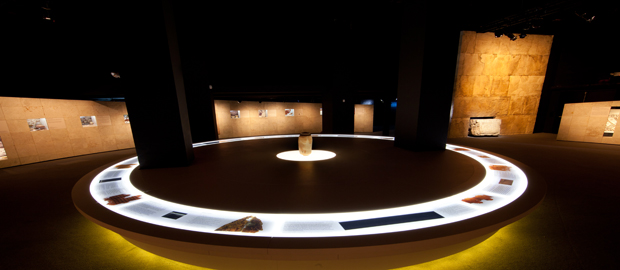Ancient scrolls inspire new interdisciplinary research
Collaboration with Museum of Science spawns art, education and music
 Photo/Matthew Peyton
Photo/Matthew PeytonFor the past six months, Brandeis University has partnered with the Museum of Science, Boston on its installation, “Dead Sea Scrolls: Life in Ancient Times,” a special exhibition that brings fragments of the scrolls and other artifacts from ancient Israel to the public eye. Tens of thousands of visitors from the Boston area and beyond have viewed the exhibition so far, and more are expected before it closes Oct 20.
Since the exhibition opened in May, professor of Near Eastern and Judaic studies (NEJS) Marc Brettler has served as informal public ambassador for the collaboration, giving lectures on the scrolls at churches and synagogues across the region, and at the Museum of Science, Boston — most recently at the invitation of the Consulate General of Israel to New England. Back on the Brandeis campus, he says the exhibition is galvanizing more than just his fellow biblical scholars.
Behind the scenes, the collaboration has sparked activity in a number of different disciplines, including many that don’t typically work with ancient artifacts. The scrolls have inspired students and faculty in fields from chemistry to musical composition to create new work, uniquely contributing to the project.
Teaching the public
Biology professor Melissa Kosinski-Collins is teaching a science practicum course exploring new ways of teaching scientific concepts. Students spend each semester working with children up to six years old at the Discovery Museums in Acton, Mass. Taking inspiration from the discovery of the scrolls, the class led a day of “expedition-themed” activities at the Discovery museums last April.
“The scrolls were hidden for thousands of years inside desert caves before they were found, so we wanted to try to translate the sense of excitement that comes with discovery to a six-year-old’s level,” says Brandeis senior Ari Boltax ’14, who took the course last spring.
Boltax and her classmates designed and ran several different archaeology-themed activities, from “excavating” buried artifacts to “decoding” secret messages made from baking soda and grape juice — a theme she notes was directly influenced by efforts to translate and interpret the scrolls.
“We wanted to leave kids with the idea of observing and questioning the world around them, just like real scientists and archaeologists do,” says Boltax.
Hands-on learning hasn’t been limited to children. Similar efforts are also underway for adults at the Museum of Science, where Brandeis students have functioned as interpreters to help teach visitors about the tools archaeologists and biblical scholars use to examine the Dead Sea Scrolls. Senior Ben Federlin ’14, a double major in classical studies and history, has spent weekends at the exhibition since it opened.
He and his fellow interpreters push activity carts, some of which were created by Brandeis students, around the exhibition, challenging visitors to match artifacts found at an Israeli archaeological site with artists’ renditions of daily life at the time the scrolls were written. The activity helps illustrate the value of finding artifacts within their archaeological context, he says.
“Just finding a jar, for example, doesn’t tell you much about the people who used it,” says Federlin, “but if you find a jar next to a plate, knife, and cooking pot, you might be able to say you’ve found an ancient kitchen. Activities like these are a great way to bring context to the scrolls, and bring history to life for visitors.”
Federlin’s stint as an interpreter isn’t his first museum experience. For the last several years, he has also been an intern with Brandeis’ classical artifact research collection (CLARC), creating interpretive exhibits of the collection — including one that drew on original research by Alison Crandall ’13, who conducted extensive chemical analysis on pottery shards from the collection to shed light on their original contents.
The music of ancient texts
In addition to scientific and educational projects, the Brandeis Dead Sea Scrolls collaboration has inspired artistic works. Professor of music Eric Chasalow’s most recent composition, “When It Finds Nothing But The Wind,” borrows stories and phrases from the scrolls in their original Hebrew and Aramaic, and sets them to music. Over several months, Chasalow worked with Brettler and NEJS professor David Wright to select and develop segments of the documents into an intricate piece for soprano, flute, guitar, percussion and electronics.
Chasalow says he chose to work with the text in layers, creating a subtle mix of live voices and electronically manipulated recordings. “The electronic voices are really voices from the past, captured in the words on the scrolls,” he says. “There’s music to those words, there’s rhythm to those words. The scrolls have a certain inherent musicality built in to them.”
The piece debuted at Brandeis’ Slosberg Music Center Oct. 5, offering an unusual blend of the ancient and modern, and giving audiences a singular perspective on the writing in the scrolls themselves.
“Eric Chasalow’s piece is a perfect example of how our collaboration with the Museum of Science, Boston has brought work in the sciences and humanities together in a really constructive way,” says Brettler. “As a believer in the liberal arts, it’s wonderful to see these sorts of connections come together on campus.”
Categories: Humanities and Social Sciences, Research, Science and Technology





